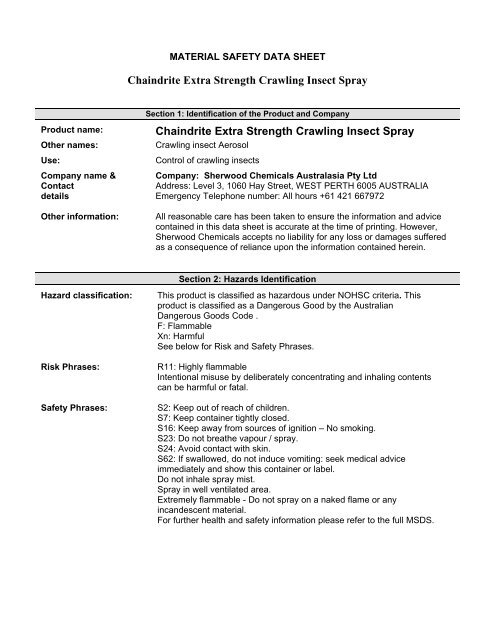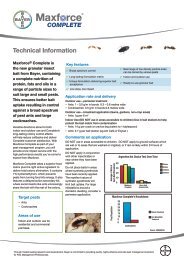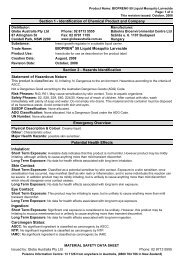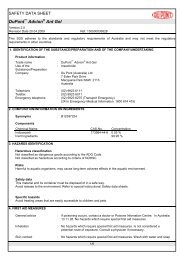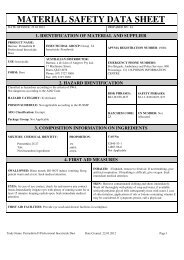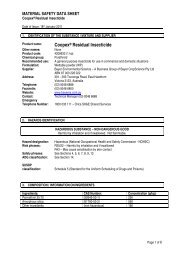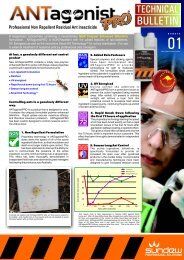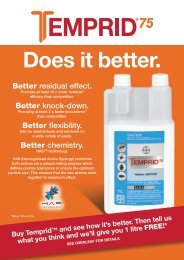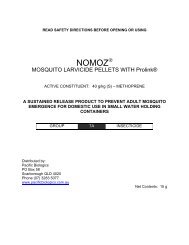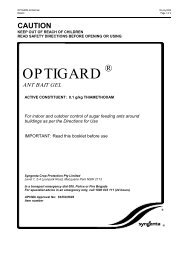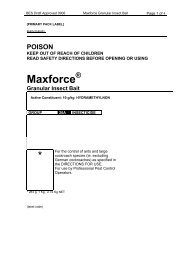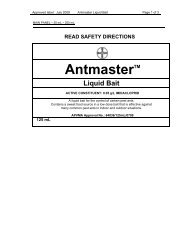Chaindrite Aerosol Spray MSDS - Knock-Out Pest Control
Chaindrite Aerosol Spray MSDS - Knock-Out Pest Control
Chaindrite Aerosol Spray MSDS - Knock-Out Pest Control
You also want an ePaper? Increase the reach of your titles
YUMPU automatically turns print PDFs into web optimized ePapers that Google loves.
MATERIAL SAFETY DATA SHEET<br />
<strong>Chaindrite</strong> Extra Strength Crawling Insect <strong>Spray</strong><br />
Section 1: Identification of the Product and Company<br />
Product name:<br />
Other names:<br />
Use:<br />
Company name &<br />
Contact<br />
details<br />
Other information:<br />
<strong>Chaindrite</strong> Extra Strength Crawling Insect <strong>Spray</strong><br />
Crawling insect <strong>Aerosol</strong><br />
<strong>Control</strong> of crawling insects<br />
Company: Sherwood Chemicals Australasia Pty Ltd<br />
Address: Level 3, 1060 Hay Street, WEST PERTH 6005 AUSTRALIA<br />
Emergency Telephone number: All hours +61 421 667972<br />
All reasonable care has been taken to ensure the information and advice<br />
contained in this data sheet is accurate at the time of printing. However,<br />
Sherwood Chemicals accepts no liability for any loss or damages suffered<br />
as a consequence of reliance upon the information contained herein.<br />
Section 2: Hazards Identification<br />
Hazard classification:<br />
Risk Phrases:<br />
Safety Phrases:<br />
This product is classified as hazardous under NOHSC criteria. This<br />
product is classified as a Dangerous Good by the Australian<br />
Dangerous Goods Code .<br />
F: Flammable<br />
Xn: Harmful<br />
See below for Risk and Safety Phrases.<br />
R11: Highly flammable<br />
Intentional misuse by deliberately concentrating and inhaling contents<br />
can be harmful or fatal.<br />
S2: Keep out of reach of children.<br />
S7: Keep container tightly closed.<br />
S16: Keep away from sources of ignition – No smoking.<br />
S23: Do not breathe vapour / spray.<br />
S24: Avoid contact with skin.<br />
S62: If swallowed, do not induce vomiting: seek medical advice<br />
immediately and show this container or label.<br />
Do not inhale spray mist.<br />
<strong>Spray</strong> in well ventilated area.<br />
Extremely flammable - Do not spray on a naked flame or any<br />
incandescent material.<br />
For further health and safety information please refer to the full <strong>MSDS</strong>.
<strong>MSDS</strong> – <strong>Chaindrite</strong> Extra-Strength Crawling Insect <strong>Spray</strong><br />
Section 3: Composition / Information on Ingredients<br />
Chemical entity CAS N o Proportion<br />
Imiprothrin 72963-72-5 0 – 1%<br />
Cypermethrin 52315-07-8 0 – 1%<br />
Solvent naphtha (petroleum) medium<br />
64742-88-7 10 – 30%<br />
aliphatic<br />
Ethanol 64-17-5 30 30 – 60%<br />
Hydrocarbon propellant<br />
- Propane<br />
- Butane<br />
74-98-6<br />
106-97-8<br />
30 – 60%<br />
Other ingredients to 100%<br />
Section 4: First Aid Measures<br />
FIRST AID:<br />
For advice, contact a Poisons Information Centre, Phone Australia 13 1126; New Zealand 0800 764<br />
766, or a doctor at once.<br />
Inhalation: Do not breathe vapour/ spray. Remove victim to fresh air. Keep victim warm and calm.<br />
If patient is unconscious and breathing, place them in the coma position, check airway and observe.<br />
Administer oxygen if breathing is difficult. Apply resuscitation if victim is not breathing. Obtain<br />
immediate medical care.<br />
Skin: May irritate skin. Avoid contact with skin. If skin or hair contact occurs, remove<br />
contaminated clothing and flush skin and hair immediately with running water at room temperature<br />
for 15 minutes.<br />
Eye: May irritate eyes. If in eyes wash out immediately with water for 15 minutes. Obtain medical<br />
care.<br />
Ingestion: Due to high volatility of product, this is not likely to occur. If sprayed in mouth, rinse<br />
mouth with water. If swallowed, do not induce vomiting: seek medical advice immediately and<br />
show this container or label.<br />
ADVICE TO DOCTOR -<br />
Treat symptomatically<br />
Section 5: Fire Fighting Measures<br />
Fire/Explosion Hazard:<br />
Extinguishing Media<br />
Small fire: Use water spray, dry chemical or carbon dioxide.<br />
Large fire: Use water spray or fog.<br />
Fight fire from protected position or use unmanned hose holders or monitor<br />
nozzles. If safe to do so, move undamaged containers from fire area. Do not<br />
approach hot containers. Cool containers with water before handling. If<br />
impossible to extinguish fire, protect surroundings, withdraw from are and<br />
allow fire to burn.<br />
Hazards Heat or damage to containers can release flammable / poisonous gases.<br />
Extremely flammable. Pressurised dispenser. Closed containers may rupture<br />
when exposed to heat greater than 50 C. Ruptured containers will rocket.<br />
Released gases can form explosive mixtures with air. Hazardous<br />
concentrations can accumulate in a confined space. Released gases can travel
<strong>MSDS</strong> – <strong>Chaindrite</strong> Extra-Strength Crawling Insect <strong>Spray</strong><br />
to source of ignition and flash back. Fire can produce irritating, poisonous and<br />
corrosive gases. Propellant is extremely flammable and heavier than air.<br />
Precautions / PPE High concentration of gas could cause dizziness or asphyxiation without<br />
warning. Released gases are harmful. Wear SCBA and protective gloves. If<br />
large amounts are involved, wear SCBA and chemical splash suit.<br />
HAZCHEM Code 3WE<br />
Section 6: Accidental Release Measures<br />
Emergency Procedures<br />
Immediately contact police or fire brigade. Spill or leak area should be isolated immediately for at least 8 m<br />
in all directions. Eliminate all sources of ignition within at least 15 m. Keep unauthorised personnel away.<br />
Keep upwind and to higher ground. When a large quantity is involved in a fire,<br />
consider initial evacuation for at least 100 m in all directions. Send message to police and fire brigade. Tell<br />
them the location, material, UN Number, quantity and emergency contact as well as damage observed.<br />
Containment / Clean up Procedures<br />
Eliminate all ignition sources (no smoking, flares, sparks or flame) within at<br />
least 15 m.<br />
All equipment used when handling the product must be earthed.<br />
If water is available, spray leaking containers to reduce ignition hazard and disperse gas. Isolate area until<br />
gas has dispersed. Ventilate area.<br />
Avoid release to the environment. Do not empty into drains. Absorb in inert absorbent material for disposal<br />
by an approved method and / or local regulations.<br />
Section 7: Handling and Storage<br />
Safe handling practices:<br />
Storage:<br />
Other information:<br />
<strong>Spray</strong> in a well ventilated area. Do not breathe vapour. Local exhaust<br />
ventilation may be necessary to minimise excessive vapour concentration,<br />
if levels are likely to be high or in a confined space.<br />
Avoid static charge and discharge with high concentrations and in<br />
confined space. Wash hands after use.<br />
Store in a well ventilated area. Pressurised dispenser. Protect from<br />
sunlight and do not expose to temperatures exceeding 50 C. Do not<br />
pierce or burn this can, even when empty. Store away from corrosive<br />
products. Store in accordance with Dangerous Goods Regulations and<br />
transport in accordance with the ADG Code for Dangerous Goods Class<br />
2.1<br />
Nil<br />
Section 8: Exposure <strong>Control</strong>s and Personal Protection<br />
National<br />
Exposure<br />
Standards<br />
Biological Limit<br />
Values<br />
Engineering<br />
<strong>Control</strong>s<br />
Personal<br />
Protective<br />
Equipment<br />
There is no extablished TLV for this product. Avoid exposure – obtain special<br />
instructions before use.<br />
TWA for Butane is 800ppm<br />
Propane is an asphyxiant<br />
Not available.<br />
Local exhaust ventilation may be necessary to minimise excessive vapour<br />
concentration, if levels are likely to be high or in a confined space.<br />
Wear safety glasses and protective gloves. Wear respirator complying with<br />
AS1715 and AS1716 if concentration levels are high.
<strong>MSDS</strong> – <strong>Chaindrite</strong> Extra-Strength Crawling Insect <strong>Spray</strong><br />
Section 9: Physical and Chemical Properties<br />
Appearance:<br />
<strong>Aerosol</strong>, fine clear spray<br />
Odour<br />
Characteristic perfume<br />
pH<br />
Not applicable<br />
Vapour Pressure<br />
Not available<br />
Vapour Density<br />
Not available<br />
Boiling / Melting Point<br />
Not available<br />
Solubility<br />
Not soluble<br />
Specific Gravity<br />
0.58 approx.<br />
Flash Point (propellant)<br />
-104 to -60°C<br />
Flammable limits (propellant) 1.5% to 9.6% in air (v/v)<br />
Ignition Temperature (propellant) 494°C to 600°C<br />
Section 10: Chemical Stability and Reactivity Information<br />
Chemical stability:<br />
Conditions to avoid:<br />
Incompatibility:<br />
Hazardous<br />
decomposition<br />
products:<br />
Stable under normal ambient conditions of storage and use. Avoid heat<br />
sources.<br />
Heat, flames and sparks. Avoid static charge and discharge with high<br />
concentrations and in confined space. Avoid damp conditions.<br />
Can react violently with oxidising agents – chlorine, pool chlorine or nitric<br />
acid.<br />
Not available.<br />
Section 11: Toxicological Information<br />
Potential adverse health effects and symptoms associated with exposure to the material<br />
Vapours may cause drowsiness and dizziness.<br />
Swallowed: Unlikely due to high volatility of product, but is harmful, may cause lung damage if swallowed<br />
Eyes: Liquid will cause severe damage, vapour may irritate.<br />
Skin: May cause cold burn. Irritating to skin.<br />
Inhaled: May cause light-headedness, dizziness and drowsiness.<br />
Excessive exposure may cause unconsciousness or even death, due to<br />
asphyxiation.<br />
Section 12: Ecological Information<br />
Ecotoxicity / Persistence / Degradability / Mobility<br />
Propellant will vapourise rapidly when released to atmosphere.<br />
Propellant consists of hydrocarbons that photo chemically decompose under atmospheric conditions.<br />
Section 13: Disposal Considerations<br />
Disposal methods Dispose of can by putting in garbage or leaving it at an appropriate metal recycling<br />
collection point.<br />
Special precautions for landfill or incineration<br />
Do not pierce or burn, even when empty.
<strong>MSDS</strong> – <strong>Chaindrite</strong> Extra-Strength Crawling Insect <strong>Spray</strong><br />
Section 14: Transport Information<br />
UN Number 1950<br />
Proper Shipping Name <strong>Aerosol</strong>s<br />
Emergency Procedure<br />
Guide 2D1<br />
Class and subsidiary risk(s)<br />
Class 2.1<br />
Packaging Group Not applicable<br />
Special precautions for user<br />
<strong>Spray</strong> in well ventilated area. Keep away from sources of ignition – No smoking.<br />
Extremely flammable - Do not spray on a naked flame or any incandescent material.<br />
Keep out of reach of children.<br />
Hazchem 3WE<br />
Section 15: Regulatory Information<br />
Agricultural or veterinary<br />
chemicals legislation<br />
This product is registered for use by the APVMA.<br />
AUSTRALIA APVMA Registration No. 63850<br />
Section 16: Other Information<br />
Emergency Telephone number: All hours Tel: +61 421 667972<br />
Sherwood Chemicals Australasia Pty Ltd<br />
Address: Level 3, 1060 Hay Street, WEST PERTH 6005 AUSTRALIA<br />
<strong>MSDS</strong> creation date: 6 th July 2009<br />
The information above is believed to be accurate and represents the best information currently available to<br />
us. However, we make no warranty of merchantability or any other warranty, express or implied, with<br />
respect to such information, and we assume no liability resulting from its use. Users should make their own<br />
investigations to determine the suitability of the information for their particular purposes. In no event shall<br />
Sherwood Chemicals be liable for any claims, losses, or damages of any third party or for lost profits or any<br />
special, indirect, incidental, consequential or exemplary damages, howsoever arising, even if Sherwood<br />
Chemicals has been advised of the possibility of such damages.<br />
END OF <strong>MSDS</strong>


